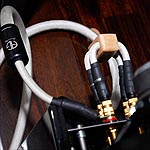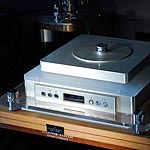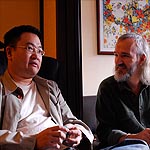|
This review page is supported in part by the sponsor whose ad is displayed above
|
||||||||||||||||||||||||||||||||||
 |
||||||||||||||||||||||||||||||||||
 |
||||||||||||||||||||||||||||||||||
 |
||||||||||||||||||||||||||||||||||
 |
||||||||||||||||||||||||||||||||||
J. Lam owns Audio Exotics, an import/retail establishment for fine audio in Hong Kong, the City of Life. The selection of brands he brings to this city nation of 200 audio establishments of all sizes demonstrate a particular sensibility. There are Franck Tchang's acoustic resonators under the French Acoustics System Int'l brand and Argento Audio's unshielded silver cables from Denmark. There's Audio Valve from Germany and analogue and tube gear from Da Vinci Audio of Switzerland. There are FAL drivers from Japan and Horning Hybrid analogue, tube amps and speakers from Denmark. There's Karan Acoustics from the former Yugoslavia and the Mosquito Neo speakers from France. There are ORB Audio power products from Japan and electronics from Orpheus Laboratories of Switzerland. There's Tron valve kit from the UK and TW Acoustics analogue from Germany. There's WAVAC and Zanden tube electronics from Japan. |
||||||||||||||||||||||||||||||||||
 |
||||||||||||||||||||||||||||||||||
When J. Lam asked whether I'd like to visit and have him introduce me to five of his best clients and their systems -- our own Linnman included -- I didn't have to think twice. 6moons' RoadTour format was especially designed to accommodate such opportunities, for learning how our virtual neighbors live with their hifis - whether a few exits down the freeway such as Michael Lavorgna routinely arranges for; in a different state such as Jeff Day's visit with Pitch Perfect Audio in San Francisco recently chronicled; or in a different country altogether. No matter, it's all on the same wavelength. If there's one thing that transcends boundaries of language, religion, culture and location, it's how listening to music provides succor, meaning and enjoyment for people around the globe. And as their interactive web forum proves beyond a doubt to anyone following just a few of the exchanges, the clients of Audio Exotics are into it for the right reason. They're decidedly not trophy hunters but music connoisseurs. What's more, they view their involvement with audio as an ongoing apprenticeship where there's much to be learned and discovered and nothing etched in stone. In short, just my kind of passionate audio nuts. |
||||||||||||||||||||||||||||||||||
With a full schedule honed to perfection by Linnman and with Marvel acting as high-class chauffeur of unbelievable punctuality (a true marvel considering Hong Kong traffic), J. Lam had secured the hospitality also of Wilson Leung, Peter Tsang and Doctor Kenneth to act as my hosts for this trip. And when I say hospitality, I mean it in capital letters. Seldom has a kwei loh or foreign devil been made to feel like such an important dignitary, an audio ambassador of sorts. Truth be told, these gentlemen -- Doctor Kenneth missing from the above photo -- were their own ambassadors, their homes embassies for audio refugees who seek asylum from sterile boring sound. The story naturally begins at Audio Exotics or AE for short, located not in the business district like all others but in a residential building whose back faces the Hong Kong University [second image below]. AE is by appointment only. There is a secret handshake to get in. But it's not the size of your wallet. You have to truly love music. You must have outgrown the silly obsession with trophy audio which is primarily concerned over brand image, what others think about it and second-hand resale value. |
||||||||||||||||||||||||||||||||||
 |
||||||||||||||||||||||||||||||||||
 |
||||||||||||||||||||||||||||||||||
Considering our Asian locale and its unique system of medicine, it seems only fitting to consider describing the different audio systems I encountered in terms of the elements: metal, wood, air and ether. Metal stands for the leading edge, wood for the bloom/body portion of a tone and air for the decay. Just as different body types and personalities require different medicine for optimum health, so sensitive listeners require a particular mix or balance of these elemental qualities to most powerfully trigger their nervous systems into conducting the subtler dimension of life force, prana or ether. Ether thus becomes synonymous with musicality, what we might call the goose bump or tugging heart string factor. It envelopes all the other qualities while partially standing aloof as senior exactly like how in a compromised concert hall and bad seat, flawed sonics can coincide with superior music making abilities. Naturally, the opposite is also possible. You can make good sound but musically, your system might remain somewhat unconvincing or not as communicative and transporting as one that exhibits obvious sonic flaws yet still electrifies your senses. |
||||||||||||||||||||||||||||||||||
 |
||||||||||||||||||||||||||||||||||
AE's system at the time of my visit sported Tommy Hørning's new Eufrodite speaker which uses four pairs of isobarically loaded woofers per cabinet. Those slender open-backed floorstanders in black lacquer were driven from Hørning's SATI 300B integrated and fronted by either the Raven turntable feeding a Zanden Audio phono stage or the Zanden Model 2000p/5000S combo with the new SuperClock. All cabling was by Argento -- which has become the de facto house brand of AE -- and Frank Tchang's resonators and diffusors could be spotted in key locations where resident room acoustics ace Linnman had put 'em. Linnman has spent considerable time with Frank Tchang to learn his method of room tuning. He by now has more than 50 rooms under his belt. This includes a small study barely large enough to house a concert grand where a young girl practicing couldn't concentrate because the piano's lower registers overloaded the room. Judicious applications of resonators fixed the problem and the young lady is no longer troubled in her practice. |
||||||||||||||||||||||||||||||||||
 |
The presence of these devices here and subsequently epitomized the resident spirit of open mindedness plus shared appreciation for the basic fact that buying the right boxes and stringing them together with cables is only the first step toward the goal. Especially in the smaller spaces typical for the city's very expensive but compact real estate, it's common to see listening rooms double as dining rooms, having to fulfill two functions at once. Treated room acoustics thus become paramount to achieving desired results while having to coexist with the decor. Enter the tiny Tibetan singing bowls on minuscule tridents grounded in small wooden panels that affix to the walls with double-sided tape. Made of copper, silver, gold or Platinum and outfitted with lateral wings, their size and apparent rationale defy common sense to make them easy targets of ridicule. If you think of them as tuning forks, you can appreciate that specific frequencies will set them off to resonate sympathetically. |
|||||||||||||||||||||||||||||||||
Considering the finger tip size of these metallic cups, you'll equally appreciate that these will be fixed and high frequencies. This is where common sense balks. The most severe room resonances occur below 300Hz. Problem areas are unique from room to room. How can resonators operating at fixed high frequencies address them universally? They clearly can't behave as basic mechanical notch filters. |
||||||||||||||||||||||||||||||||||
 |
||||||||||||||||||||||||||||||||||
| No more needs to be said to suggest why most commercial audio establishments wouldn't be caught dead promoting these items. They smack of voodoo. Technically astute clients will insist on explanations that seem unlikely to convince them based on accepted acoustic theories. Nevertheless, they work. Asked what the price ceiling was for a worst case scenario, Linnman offered that based on the 50+ rooms he's treated, nobody to date had to | ||||||||||||||||||||||||||||||||||
| spend more than $5,000. Most got by on considerably less. That figure will seem high looking at the actual hardware only before you admit that many 'philes spend that amount on a single designer power cord that'll be utterly ineffective at addressing the particular problems these resonators do. In Peter Tsang's Kondo/Hørning system further down this report, Linnman affixed a single silver resonator on the wall behind the speakers. We all heard the improvements in tauter bass and cleaner midrange. Peter wouldn't allow Linnman to remove it again. "Send me the bill." Signed with a smile. Hearing is believing as they say. It's something naysayers operating in the dark of predictive theories will gladly overlook. They'll prove, on paper and in the chat rooms, why these devices couldn't possibly work. C'est la vie. |
||||||||||||||||||||||||||||||||||
 |
||||||||||||||||||||||||||||||||||
Like all Hørning speakers, the Eufrodite uses a neutered Lowther. Its whizzer cone has been removed, its operative bandwidth restricted to where a dedicated tweeter handles the treble and an array of woofers the bass. In its present incarnation -- relatively new and still undergoing final break-in -- this setup had sonic problems in the 40-60Hz band where the bass was highly resonant and boomy to muddy up proper assessment of the elemental balance on my test CDs. After hearing Peter Tsang's system two days later, his Eufrodite driven from Kondo Gakuoh 30-watt p/p 300B monos in a considerably smaller room were free of these bass issues. Without the time to experiment with speaker placement or amp substitutions at AE's, I wasn't able to determine the cause of the bass boom. Tommy Hørning's comment that he had voiced this model on his own 300B amp suggested that contrary to our shared strong suspicions, it was probably not his SET being underpowered or insufficiently damped but the speaker positioning in the room which was the culprit still. |
||||||||||||||||||||||||||||||||||
 |
||||||||||||||||||||||||||||||||||
Spinning specific baroque music on the Raven turntable completely avoided setting off the boom. Under those circumstances, I heard a very well-balanced sound, meaning that the metal, wood and air elements were all properly accounted for, none of them exaggerated or unduly diminished. Contrary to Lowthers run full-range, the Eufrodites were entirely free of shoutiness as well as tonal leanness which often accompanies exceptional speed and rise times. Simply put, they made music. In fact, the wood or tone element was very much present and -- clearly not coincidentally -- mirrored in Frank Tchang's judicious use of select woods in the Acoustic Systems stands supporting the hardware. Structurally very basic, these racks avoid all metal - no screws, nails or spikes. Even the speakers sat on wooden pucks. Listening to unfamiliar music over the Raven rather than my own CDs didn't allow for a complete sonic assessment but my hunch is that reorientation along the long wall might solve the present narrow band room node issue to become a very impressive setup indeed not just musically -- which it already is -- but also in a strict HiFi sense. (Incidentally, the big white units on the floor are the driver stages for the Da Vinci Audio power amps which we didn't play.) |
||||||||||||||||||||||||||||||||||
 |
||||||||||||||||||||||||||||||||||
J. Lam also runs a music school and owns interest in a restaurant in the gambling paradise of Macao among other business ventures. This affords him the luxury of operating AE without the usual hard-sell pressure tactics. He views AE as a cultural institution instead and his main function as an educator and facilitator. Two years ago, he was the first to organize a Hong Kong HighEnd audio presentation where live musicians alternated with playback demos to educate attendees and where musicians shared their observations about the differences. My visit fell into this cultural exchange milieu too. As Humphrey Bogart said so memorably in the closing line of Casablanca, I believe that this encounter with AE was merely a beginning. |
||||||||||||||||||||||||||||||||||
 |
||||||||||||||||||||||||||||||||||
| J. Lam laughed about "burning money" when it comes to operating an audio establishment in direct opposition to Hong Kong's mainstream which views this 32-year old upstart and his unconventional ideas with perhaps a bit of trepidation. J. Lam takes delight in swimming against the stream. His growing and very loyal clientele suggests that he isn't alone in believing that change is necessary in the prevailing domestic climate of trophy audio worship. The fact that he operates a music school whose students, parents and teachers necessarily know what real instruments sound like merely adds to his unique profile as perhaps the City's youngest retailer of upscale exotic audio. |
||||||||||||||||||||||||||||||||||
 |
||||||||||||||||||||||||||||||||||
As a networker and visionary, J. Lam has some exciting boundary-crossing ideas for the future. I've already happily pledged 6moons' support. You see, on one level, audio is nothing but flashy boy toys. It's about ego gratification and all manner of silly one-upmanship. On another level, audio appeals to the mysterious element I've called ether. When magnified, it stimulates our very core during listening to the kind of music that calls on our feelings. That's the common ground that then transmutes into Stevie Wonder's higher ground. Listeners, go on listening. Sharers, go on sharing. It's this focus and its possible creative outcomes which have me excited, not the shiny toys. AE's expanded family of music lovers practice the same ideals. Who knows what supportive endeavors can spin out from our meeting? Being invited into the homes of complete strangers where, within minutes, the aroma of a shared passion suffused everything was clear evidence that despite its considerable trappings, our hobby has the potential to be far more. Stay tuned as J. Lam, Linnman and I explore our next steps together. Compliments of Mr. Gen Pau of the eponymous photography studio, here are more images of AE's setup, with the cropped thumb nails opening in a new window in full 800 x 600 size. |
||||||||||||||||||||||||||||||||||
|
||||||||||||||||||||||||||||||||||
 |
||||||||||||||||||||||||||||||||||
 |
||||||||||||||||||||||||||||||||||























